Thursday Dec 04, 2025
Thursday Dec 04, 2025
Tuesday, 25 October 2016 00:01 - - {{hitsCtrl.values.hits}}
By Thulasi Muttulingam
When the severely war-affected people of Sri Lanka’s north and east made it out of the refugee camps containing them from 2010 onwards, they had a new dilemma to face: Where to live?
“We became displaced in 1983 and had been on the move ever since. We thought we’d return in three days, which turned into three weeks and then three years… it was eventually nearly 30 years before we could see our beloved land again.
“When we finally saw our village in 2010, we found our houses destroyed, our wells caved in, and our lands overtaken by forest,” says K. Palasivarasa (74), a farmer from the country’s war-torn Wanni region.
Sri Lanka’s long-drawn brutal civil war drew to a close in May 2009. Many of those who had made it out alive had battled constant displacements, death and destruction among themselves, before finally making it to Sri Lankan Army run territory, where they were then placed in refugee camps. The camps took years to close as the people’s lands had to be cleared of landmines and other hazards first.
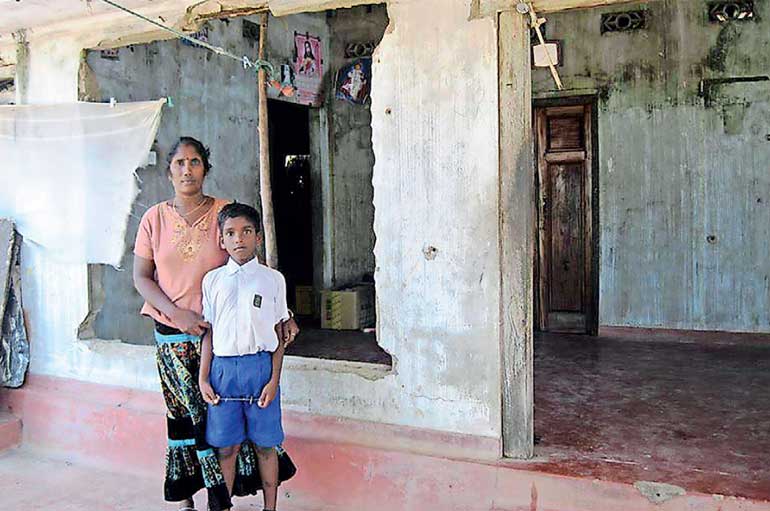 A family returned to their ancestral home in Jaffna from a Tamil Nadu refugee camp; they currently lack the funds to repair it
A family returned to their ancestral home in Jaffna from a Tamil Nadu refugee camp; they currently lack the funds to repair it
Some of those lands became demarcated as ‘High Security Zones’ by the Sri Lankan Government which left the people of those areas bereft of their lands. There are still people living in refugee camps today seven years after the war ended, waiting for the Government to release their lands. Many more languish in refugee camps in Tamil Nadu as well. Meanwhile the first of those to be released from refugee camps to go back home in early 2010 did not feel particularly fortunate either.
“Our lands had been overtaken by jungle shrubs and we found them infested with wild animals. Snakes, wild pigs and elephants were running amok. We did not possess the funds necessary to clear our lands at that time. So we sheltered under trees until aid agencies came to our rescue with temporary shelters for us to live in,” recalls Prema, a single mother of five in Mannar, Northern Province. Prema’s husband died in the last stages of the war in 2009.
A shell piece from an aerial bombardment split his head open and he dropped dead in front of her. She still has nightmares of the incident and is under medication for post traumatic stress. There are many such war widows left behind like her, struggling to bring up their children as single parents in a traditional Tamil community that had not equipped them to be breadwinners, while also still struggling with the traumas left behind by war.
The temporary shelters the refugees were first given to settle in, were erected with corrugated iron and tin sheets, meant for only six months’ occupation – yet as it turned out, they have served as homes for the people for three to five years and more now. There are still people living in these shelters today for lack of anything better, even though the structures have become derelict now.
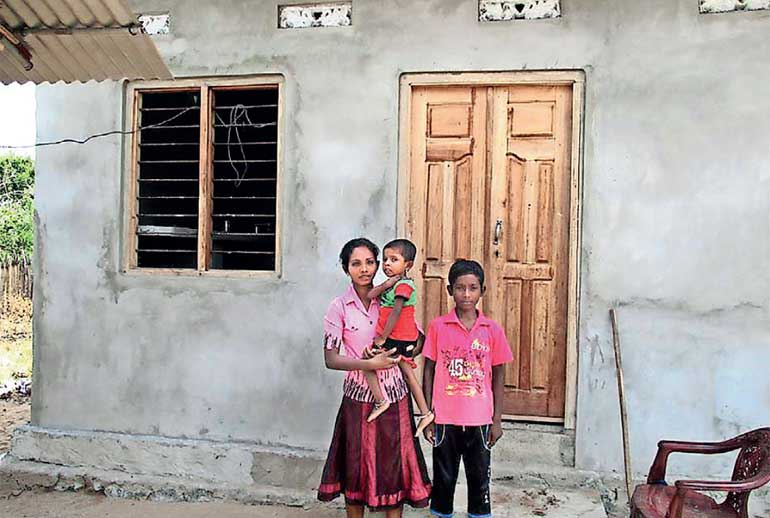 A single mother and her family in front of their new house
A single mother and her family in front of their new house
It was in these circumstances that the Government of India signed a memorandum of understanding with the Sri Lankan Government to build about 50,000 permanent homes for the war-affected people of Sri Lanka. When the MOU was signed in 2012, people were ecstatic. They had lost all their material assets in the long drawn out war and having a permanent roof over their heads was but a dream – a dream that the Indian Government pledged to deliver.
The project was planned to take an owner-driven approach, with the beneficiaries being responsible for building their own houses – while the Indian Government enlisted the aid of several high profile aid agencies such as UN-Habitat, International Federation of Red Cross and Red Crescent Societies (IFRC), Habitat for Humanity and the Sri Lankan Government’s National Housing Development Authority as implementing partners in a supervisory capacity.
Unfortunately, the reality of achieving this dream has not been a smooth process. The last four years in the North and East of Sri Lanka have been quite turbulent for the resettled refugees, despite the war being over. Much of their stress could be directly attributed to the houses they were building.
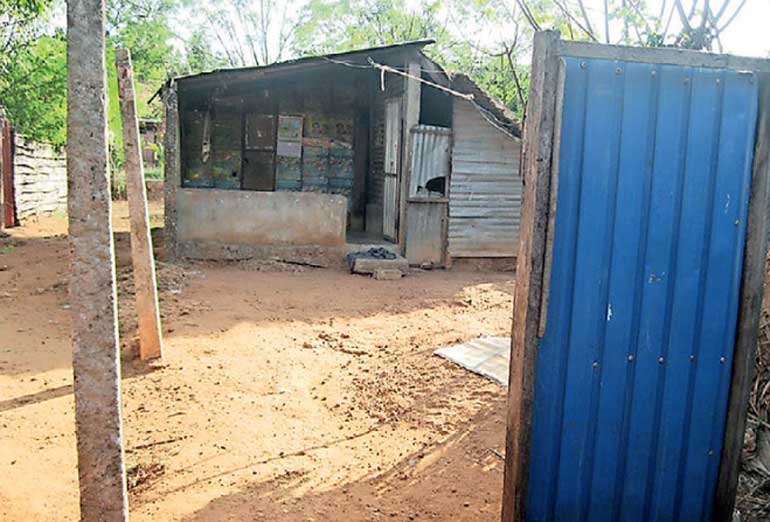 A temporary shelter still in use in the north
A temporary shelter still in use in the north
“Imagine planning for something as simple as a family wedding? How many months would you plan in advance to make it go off without a hitch? And even then you would experience some hiccups along the way due to unforeseen and uncharted challenges. Extrapolate that then to what the Indian Government tried to gift the Sri Lankans. Of course some things went awry and we drew a lot of criticism for it,” says A. Natarajan, Indian Consul General stationed at Jaffna, Sri Lanka.
The Indian High Commission opened up a consulate in Jaffna in 2010, in order to better promote the Indian Government’s various infrastructure and development activities in these war affected regions of Sri Lanka. However, as Natarajan, Jaffna’s Consul General noted, even the most careful planning and goodwill could still go amiss. The Indian Housing Project in the North of Sri Lanka has come to a close now. 41,950 houses (two-bedroom stone house units with attached kitchen and toilet) have been built while a further 1,000 part-damaged houses have been repaired. The full grant value of the project is estimated at $ 270 million.
Each of the individual housing units however was allocated a cost of only Rs. 550,000. “We did a pilot study in the provinces before we launched the project that made us believe that this amount was enough. However, due to later inflation in cement and other prices, many people did struggle to complete their houses within this allocated grant money,” explains S. Niranjan, Consul (Development – Cooperation) at the Indian consulate in Jaffna.
From the project’s launch in 2012 till its end in early 2016, an agonised people leapt through various hurdles to first gain the housing, and then complete it. The hurdles had not been put there to make life difficult for them but to ensure that they were awarded the housing grant in a transparent manner – which involved the fulfilment of various rigorous criteria that they had to prove; to be genuinely war affected, to be in need of a house, to possess titles to their own land and so on.
Scrambling to get the paperwork secured for all this was not an easy matter. In the meantime the Indian Government prioritised certain groups recognising their special needs; war widows and the war-disabled. These groups were sure to get a house for their families – but unfortunately the plan did not extend to taking their special needs into account while actually building the house.
“This housing project was designed to suit a family with an able-bodied male as the head of the family, who could help with the construction of the house as well as supplement the grant’s shortfall in cash with his own earnings,” says J. Nirmala, an aid agency employee and activist working in the Northern Province.
“Nuclear families which did have such an able bodied man about the house were able to build the housing with relatively little difficulty – yet most of the families left behind in these regions are those of war-widows and war-disabled men. They were not equipped to put in the bodily labour work needed, or earn the Rs. 250,000 that was the shortfall made up by the grant.”
Although the grant was originally intended to make up the full cost of the housing, many people found that they could build only 2/3 of their house with it. So they have had to go into debt to complete the housing; debts that most of these war ravaged people being wage labourers, are not equipped to settle easily.
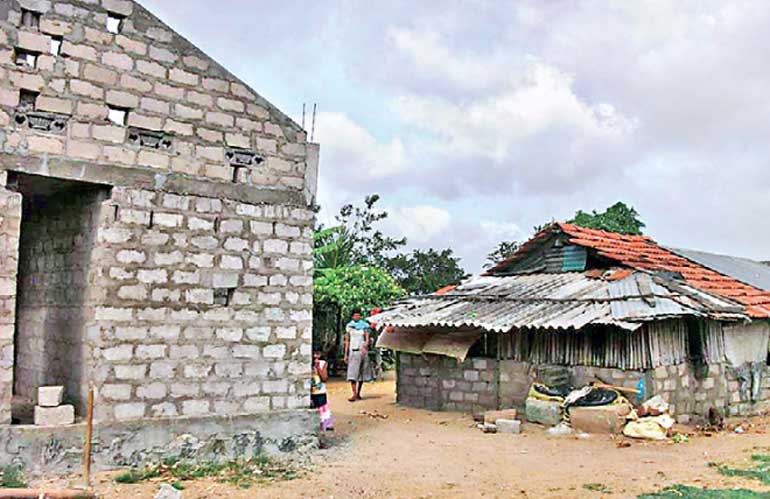 One of the new houses being built; in the backdrop is the temporary shelter the family are living in
One of the new houses being built; in the backdrop is the temporary shelter the family are living in
Over the years, it has led to threats of foreclosure of the newly built houses on mortgaged land by banks, along with attempted suicides by the traumatised grantees. In the meantime there have been whispers of far more serious transgressions against the people, aired occasionally and then hushed up again; sexual abuse of the war widows. “The women were vulnerable,” explains an aid agency worker who declined to be named. “In a culture where widows are heavily stigmatised and marginalised, where there would be heavy social repercussions of being seen even talking to men, where they were not equipped to know anything about carpentry and masonry work, where they were not equipped to be breadwinners either but had to pay out significant amounts of money in order to complete the house – what would you expect? The builders robbed them blind, and often tried to take advantage of their vulnerability to gain sexual favours.”
While people have ready anecdotes to tell, the allegations have mostly not been proven. “Only one Jaffna based paper carried allegations of this sexual abuse. I did not hear of it from any other quarter,” refutes A. Natarajan, the Consul-General in Jaffna. “These allegations were taken so seriously however that they were discussed all the way up in the Indian Parliament.
“At the end of the day, we fail to see how the Sri Lankan people could fault the Indian Government even if such transgressions did take place. Our intention was to gift the people with the security of permanent homes after their long years of trial. We planned long and hard and enlisted the very best international housing-aid agencies in the field as well as the active collaboration of the Sri Lankan Government. If despite all this strategic care, some women were abused under this project, it is their own fellow Sri Lankan men who are culpable, for which we should not be held answerable.”
Now at the end of the project however, several stone houses dot these regions where only tin shacks once stood. “I had to go into severe debt and contemplated suicide several times during the process of house building,” recalls R. Kala (26) a single mother of one. “Now, however, it’s finally over. I am still in debt but I am slowly paying it back. It’s humiliating to get lambasted by debt collectors when I don’t have enough money to pay them back, but at the end of the day, I do have the security of my house to sleep in. It means a lot to me and my son, and I am thankful that the Indian Government facilitated it.”
The housing project delivered various other associated benefits as well. “As long as the project lasted, able bodied men in these areas did not lack for work opportunities. Everybody became masons and carpenters overnight and we were able to earn well with it,” notes A. Selvarasa (32), a farm labourer who had taken up masonry work as more profitable.
There are still many people left behind without houses and there are various other projects sponsored by other countries and/or the Sri Lankan Government to make up for this shortfall – yet generally the people agree, the Indian Housing Project was the most suitable. The other housing projects have come in for far more criticisms on their lack of suitability to the terrain or the people’s needs, or for their lack of transparency and accountability.
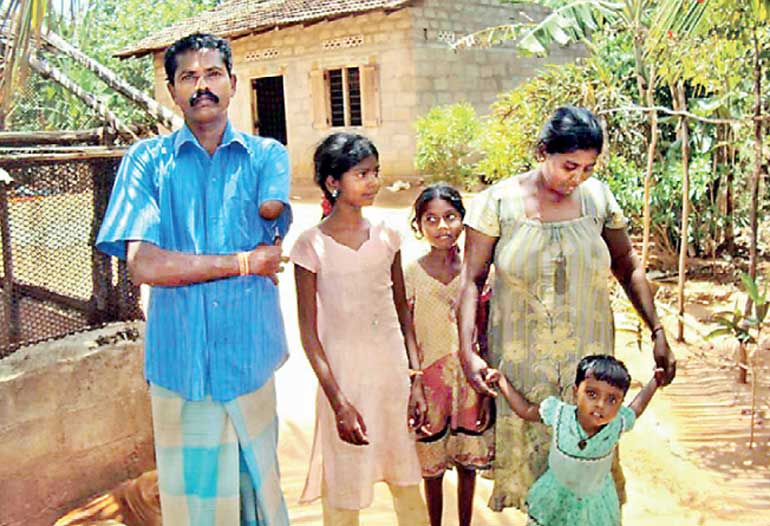 A war-disabed man and his family in front of their new house
A war-disabed man and his family in front of their new house
A case in point would be the 65,000 prefabricated houses of French-Indian steel company ArcelorMittal at a cost of Rs. 21 lakhs each that is being proposed by the current Government. There is a severe backlash against this housing scheme by civil society in general because it is at a cost that is several lakhs more than a house funded by the Indian Government while using far inferior materials that are not suited to the people’s needs or the environment. Whereas the Indian houses are durable and solid structures made of stone and cement, the ArcelorMittal houses are attractive but flimsy pre-fabricated structures.
While beneficiaries of the proposed alternate housing schemes are left blinking therefore, the beneficiaries of the Indian Housing Scheme feel grateful currently. “Nothing worth gaining is gained without stress, sweat and tears,” shrugs Palasivarasa, the farmer who returned to his home after 30 years to find it overtaken by jungle.
“For nearly 30 years as we displaced, my family and I were dependant on the goodwill of strangers who would allow us to set up a hut on their lands. To now finally, have this security of my own permanent house on my own land is not something I could have achieved on my own, so soon after the war ended. I’ll be paying off debts for quite a while but it is worth it. If this message is going to reach the Indian Government and the Indian people, please tell them we said: Thank You.”
(This article was originally written for Sroll.in, wherein a corresponding version has already been published).